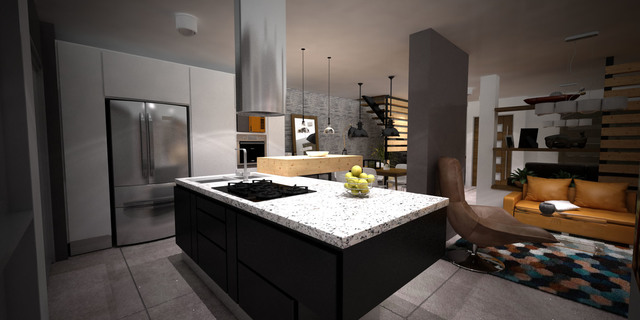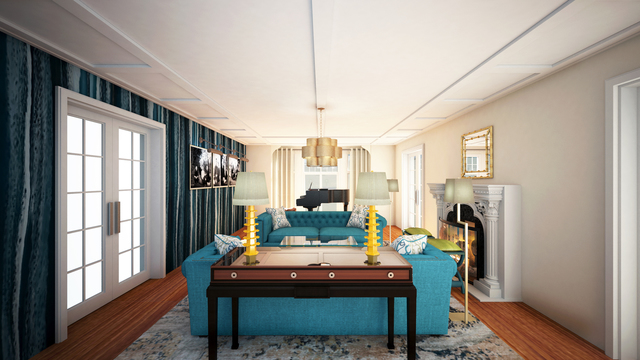Technology has affected all industries, and the real estate business is no exception. The housing market is as crowded as it has always been, with younger, more tech-savvy buyers becoming the dominating force. Real estate agents have no choice but to adapt to this emerging group of customers and work with architectural design services. One of the most recent developments in the industry is VR technology’s use to give potential buyers a virtual tour of a property, allowing a realtor to make sales remotely.
The process of selling and buying a house has been pretty much the same since forever. It typically starts with a real estate agent providing a list of properties currently in the market to a client. Next comes the usual presentation filled with explanations of why the house is perfect, followed by negotiations. The client and the realtor follow up by visiting the actual property to look at the details and get a more realistic sense of the atmosphere inside. If the client agrees with the price, then a deal can be made.
Welcoming VR
Thanks to digital photography and 3D CAD applications, realtors have another option to market properties to potential buyers. Instead of showing pictures and home-made videos to clients, many agents are now offering a much more sophisticated version of a sales presentation in the form of a virtual reality tour.
Viewed through a VR headset, the tour takes clients into an immersive digital experience in which they can explore and interact with the virtual property as if they are actually inside the building. In reality, they are far away.
How it works
A VR headset uses a clever combination of LCD and lenses to create an illusion of field depth. Images, videos, and animations built for the platform appear as if they are parts of the natural world when seen through the headset. Unlike a typical video or images seen on screen, there is no clear boundary in VR; the view is all around the person wearing the headset. A head tracking system is mounted on the headset to track movement and almost instantly adjust the projected image.

It is possible to add texts or audio commentary to the virtual tour, making it an ideal marketing platform for realtors all around the world. For example, when a client sees a bathroom, an audio commentary explains details like dimension, fixtures, colors, materials, etc. An obvious benefit of working with a 3D architectural visualization service for the real estate business is how realtors can now perform sales presentations for clients located many miles away from the property.
Suppose in the old days, a client feels the need to make a visit and see the property directly to feel the atmosphere of being inside of it. In that case, VR technology gives the same experience without requiring the client to be physically there.
RELATED: Furniture Catalog: Top 5 Ways that 3D Product Rendering Can Help Your Sales
For the realtor, a VR tour allows them to make fewer trips to the property for sale. Realtors have to be very familiar with the property to be able to make an accurate sales presentation. They make frequent trips and make notes on the essential details to highlight. Unpopular features must be noted because curious clients will want to know whether those features can reduce the price during the negotiation.Things get difficult if one realtor has to manage the sales of multiple properties. There will be more trips and expenses even before meeting the first client.
For buyers, the technology allows them to explore a property at their own pace without pressure from any realtor. When the house is not as well-built as promised in the advertisement, there is no disappointment from investing time, energy, and money in a real-life visit. It is like window-shopping, but for a house, a VR tour is the most convenient answer when customers want more than curb appeal. VR tour makes distance irrelevant.
Some argue that VR tours are not intended to sell houses but primarily to streamline marketing and affirm leads. When a potential buyer comes to a real estate agency to have a virtual tour, yet the person still wants to visit, the agency can be sure that this client has a strong interest in purchasing.
360 camera
Let us start with the least expensive type of virtual reality experience available for a realtor. This method requires 360-degree panorama rendering services to use cameras placed in the most strategic positions to capture multiple images in every room. One of the most common camera brands used for this application is Matterport. Realtors can then utilize the brand’s existing web platform to transform the captured images into a VR format.
The process is all done automatically with minimum input from users, so every realtor who can use the camera should develop a VR tour of a property to sell. It is the cheapest option, although that’s still not very cheap. Matterport Pro2, a 360-degree camera designed for real estate application, starts at a little less than $3,400 with a monthly subscription fee starting at $69 for a “Professional” account because the company does not allow spaces created with the Pro2 camera to be uploaded to the less expensive “Free” and “Starter” subscription plans.
The subscription fee covers the cost not only for using the image processing platform but also for hosting the 3D models. Realtors can then share the models with potential buyers to have a VR tour of the properties. Some realtors avoid the upfront cost entirely by hiring photographers to do the job for several hundred dollars per property.
VR based on CAD
A better (and higher-priced) option would be to have a full virtual unit built based on CAD drawings. The realtor needs to have a comprehensive technical drawing of the property and send it to the VR developer for further processing. A VR developer will then create hyper-realistic renderings of the property from the CAD file, which buyers can navigate through and explore from a computer or game console such as a PlayStation. More importantly, the rendering can be based entirely on the CAD file instead of the physical building.
The cost for commissioning the job to a freelance 3D AR/VR architectural service can range from $1,000 for basic 3D models filled for the most part with preset details to as much as $15,000 for a complex, highly detailed rendering to match the property’s exact specification. This includes textures, panoramic views, and animation. It can cost more if the VR experience must include interactive objects, just like a video game.
You probably think that $15,000 is a ridiculous amount for what is essentially a glorified video game that anybody can play and finish in an hour or so. It costs that much because the game engines typically used in the rendering process are expensive, to begin with. The virtual experience created, however, is as convincing as physically being inside and around the property. VR architectural services take advantage of game engines because they provide smoother motion and lifelike animation that allows property buyers to explore the virtual world with much better accuracy.
Full VR setup
Especially for realtors who can afford to get the full VR setup with the specialized headsets and large screen as well as interactive controls. It would take another $5,000 in addition to the $15,000 for the rendering. Even with the typical 3D CAD option, buyers can navigate through a realistic rendering on a computer screen and interact with objects using a mouse or game controller, but this is not a true VR experience. To get the most immersive tour inside a property, buyers need to become parts of the virtual world.

They can do that by using VR headsets with interactive controllers. Rather than seeing everything through the screen, specialized headsets bring them inside the virtual property where they can walk, explore, and interact with objects they see. Unlike in videos or animations with pre-determined durations, buyers can spend as much time as they want inside the virtual property.
They have the opportunity to take a closer look at every room, furniture, appliances, decoration, and so on. Some VR experience also gives a spatial sense of the property’s dimension and location relative to other structures in the area.
VR platforms
If the target buyers are clients who already own VR headsets, it is best to hire a freelance 3D virtual reality rendering service that can compile a multiplatform digital tour. The most popular platforms today include Oculus, Valve Index, PlayStation VR, and HTC Vive. As mentioned earlier, this is a full-scale virtual reality tour with all the bells and whistles. Once the tour is ready, realtors can send the file to their clients or upload it to the platform’s store.
RELATED: What are 3D Renderings & Why Your Company Should Use Them
To reach the widest possible audience, it is best to choose a mobile or web platform, which can provide the same basic visuals and functionality of VR but without the immersive effects. You can upload the file to YouTube or other video-sharing sites for everyone to access. A virtual tour can be guided or interactive. With the guided type, the audience (in this case, property buyers) don’t have to do anything other than watching the presentation.
They sit back and enjoy pre-recorded video or animation that takes them to different parts of the property. It’s like watching and being inside a movie at the same time. An interactive tour gives buyers the chance to explore and roam freely inside the virtual world. They can also touch and move objects in their surroundings. VR controller is necessary to access the available interactive features.
Cad Crowd’s architectural services are at your disposal
At Cad Crowd, we have the privilege of working with some of the best architectural freelancers on the market. Regardless of the type of project you need help with, we can connect you with a qualified freelancer. Find out how it works today.
